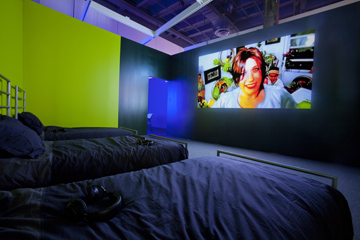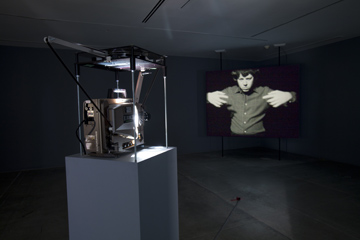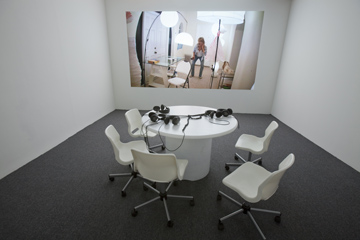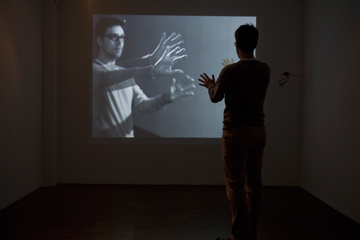
Ryan Trecartin, “Any Ever,” 2010, installation view. Photo by Steve Payne, courtesy The Power Plant.
It is neither a secret nor a surprise to know that, regardless of broad worldly appeal, the average Louvre visitor views the Mona Lisa for a scarce fifteen seconds before moving on. In comparison to this unmoving matriarch of art history, one almost expects film and video art to defy this short attention span by virtue of its tendency to unfold over a longer period of time. However, in my capacity as both artist and critic, I have all too often witnessed people bring a new flavor of evasiveness to the viewing of time-based works. The darkened gallery space is approached tentatively like the site of an unseemly peep show, where the visitor clings hesitantly to the threshold of the room – inevitably hindering the entrance of braver souls – before slinking off with the visible shame of one who feels he/she has failed to get the point of it all.
Rather than turning a blind eye to this phenomenon, it is more productive to acknowledge the very real and physical challenges presented by film and video art in order to appreciate the transformative potential of a thorough engagement with this temporal, and sometimes spatial, burden. In a cumulative context such as the recent Images Festival (a Toronto-wide exhibition that pushes the time limits of even the most seasoned art viewer — after one day of gallery visits, my pupils had dilated to twice their usual size), these challenges can be rewarded or exacerbated by the intent of the artist, who is increasingly conscious of the viewer’s presence as an indispensable part of the finished work.
At The Power Plant, which contributed to this deluge with four separate installations, the role of the audience is immediately apparent in Peter Campus’s Anamnesis, an early work dating from 1974. From a distance, Anamnesis is a blank projection of the gallery’s empty wall with the sneakiest hint of floor, waiting for the viewer to arrive and fulfill its function as an artwork dependent upon human presence. The viewer’s arrival is captured on a closed-circuit video camera that literally pulls the body into the projected space. Even more insidious is the three-second delay that drags the appropriated likeness out-of-sync with time. These ghostly echoes preserve past movements for several disquieting moments, though even these vanish shortly after the viewer’s withdrawal from the camera’s reach, unrecorded and infinitely unique. Part of the work’s liberating appeal is owed to this lack of enforced duration and accompanying promise of a participatory voice.

Joachim Koester, “Hypnogogia,” 2010, installation view. Photo by Steve Payne, courtesy The Power Plant.
The viewer experiences a similar sense of agency in Joachim Koester’s installation, Hypnogogia. The darkened space, with its repeating film reels rattling away, creates its own sense of non-linear time, leaving the viewers at liberty to wander through the room at their own pace. Given the angled placement of the suspended screens and the novelty of clunky film projectors unfamiliar to the contemporary eye, the need to move through this space is immediate. Much like the tarantism being feigned by the dancers in Koester’s films, this installation enacts a darkly psychedelic influence upon the viewer, whose body is absorbed into the space of the work as an active explorer.

Ryan Trecartin, “Any Ever,” 2010, installation view. Photo by Steve Payne, courtesy The Power Plant.
In the hands of an artist like Ryan Trecartin, the immersive potential of what The Power Plant’s curatorial statement addresses as “screen space” reverses the active role of the viewer, lulling one instead into a state of passive reception. From the confounding maze housing seven screening rooms for Re’Search Wait’S and Trill-ogy Comp to the seemingly endless loops of erratically edited video (their combined duration exceeding the opening hours of The Power Plant), everything in this installation is designed to entrap the viewer within a narcissistic feedback loop of rapid-fire digital era imagery. This is not unlike the unwitting paralysis of a web addict losing an entire day watching Der Untergang video memes on YouTube.
Mechanisms set in place to control the viewer’s experience of these digital video projections reinforce this passivity. Audio accessible only by wired headphones keeps the viewer tethered to a seating arrangement that, more often than not, responds directly to the content of a given video, drawing the viewer ever deeper into Trecartin’s maddening world. From a picnic table to abbreviated bleachers reminiscent of high school, the viewer occupies physical spaces in keeping with the adolescent lives perversely at play on the screen. In cases where the viewer is made to lie in a bed or recline in an airplane seat, identification with the video’s neurotic subjects borders on the self-annihilation that already afflicts Trecartin’s media-obsessed characters. Much like Campus’s Anamnesis, the viewer’s presence is complicit in the making of this work, but Trecartin’s control of the scene drains action from the body, makes the viewer receptive and alarmingly malleable.
This hollowing out of experience to mere seeing and hearing is not without value, once one escapes Trecartin’s maze of rooms and crosses The Power Plant’s central dividing corridor into the blank cavernous calm of Sharon Lockhart’s Podwórka. Her documentary portrait of Lodz, Poland is video stripped bare to its essential form: light projected large upon a blank wall, insubstantial but impossible to ignore. As one watches the indifferently filmed children at play in their highly adaptable urban spaces, the emptiness of this gallery is amplified. Without distraction, there to do but on the glimpses Lockhart offers of these other, youthful lives. It is a contemplative work of the mind rather than an experience of the body, bringing the viewer back around to that first prolonged love between you and art, with nothing else in between.
Stephanie Vegh is an artist and writer based in Hamilton, Canada.




Pingback: Seeing and Time: Video Art as Experience on Art:21 | Stephanie Vegh
Pingback: Welcome Back | Art21 Blog